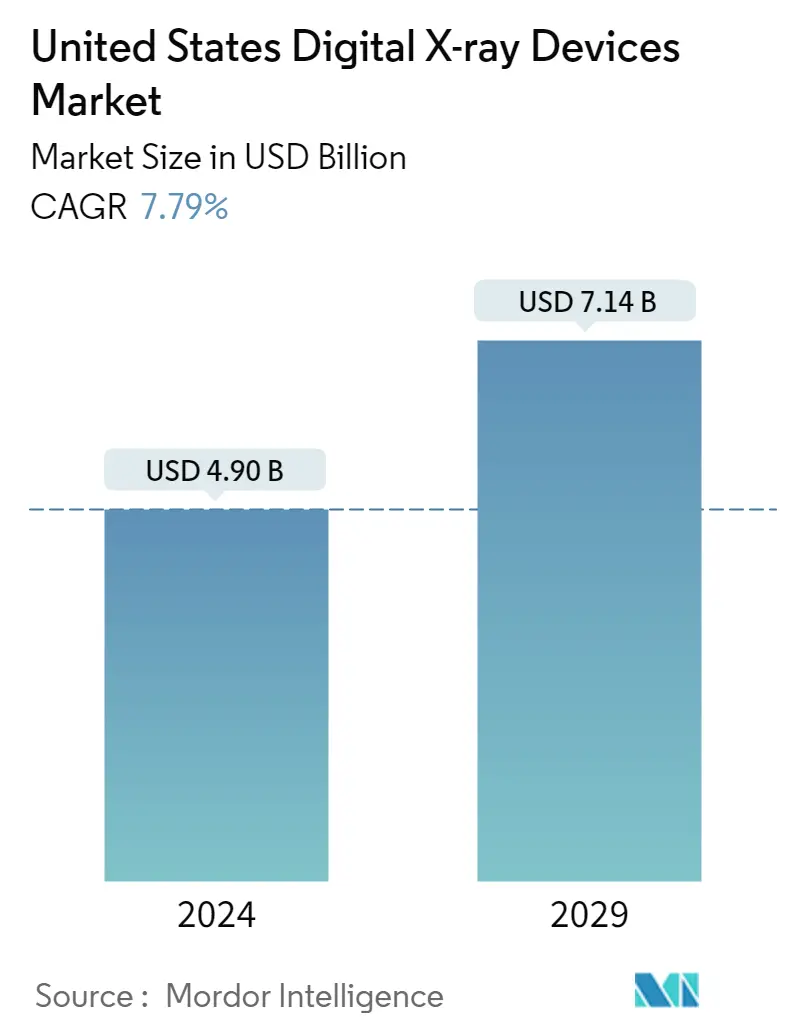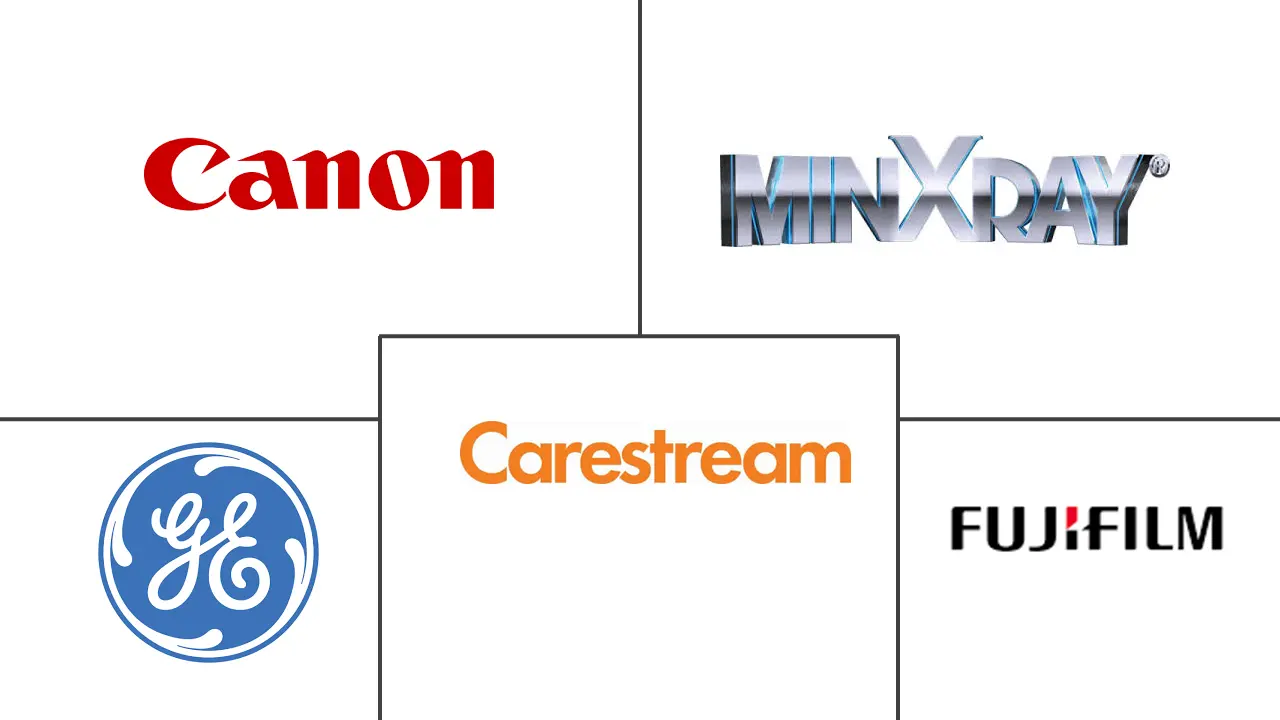Market Size of United States Digital X-ray Devices Industry

| Study Period | 2019 - 2029 |
| Base Year For Estimation | 2023 |
| Forecast Data Period | 2024 - 2029 |
| Market Size (2024) | USD 4.90 Billion |
| Market Size (2029) | USD 7.14 Billion |
| CAGR (2024 - 2029) | 7.79 % |
| Market Concentration | Medium |
Major Players
*Disclaimer: Major Players sorted in no particular order |
U.S. Digital Radiology Devices Market Analysis
The United States Digital X-ray Devices Market size is estimated at USD 4.90 billion in 2024, and is expected to reach USD 7.14 billion by 2029, growing at a CAGR of 7.79% during the forecast period (2024-2029).
The shift from conventional X-ray imaging to digital X-Ray imaging is a rapid process, and it is expected to become the most widely used imaging method in the United States.
The COVID-19 pandemic is expected to boost the growth of the digital x-ray devices market in view of the increasing demand for chest X-rays. Also, digital X-ray devices provide digital images, which is a very important advantage amid the current pandemic, as the maintenance of films could lead to a tedious workflow. Also, many players are actively involved in the development of advanced digital X-ray imaging solutions to be used for COVID-19 diagnosis. For instance, in May 2020, the United States FDA approved Aspenstate's AiRTouch Portable X-ray System to obtain rapid chest X-rays among the SARS-Cov-2 virus-infected patients. Thus, in view of the ongoing pandemic and the extensive use of imaging solutions for the accurate diagnosis and treatment of infection in patients, the digital X-ray devices market is expected to be significantly impacted.
The advantage of exposure to a lower radiation dose by patients is expected to boost the adoption to digital imaging and, thus, aid in the increase of workflow and efficiency, along with the increase in patients' safety. Currently, with the surging costs of medicines, lowering the cost per procedure while increasing safety is important for better patient care.
The Consolidated Appropriations Act of 2016, which favors digital imaging over other methods, reduces Medicare payments by 20% for providers using analog X-ray studies. Thus, for those performing imaging studies on computed/digital radiography equipment, payments may be reduced by 7% during 2018-2022 and 10% thereafter. This factor may positively influence the growth of the United States digital X-ray devices market.
Also, as per the research article titled 'Femoral Neck Fractures 2020', annually, there would be approximately 300,000 cases of hip fractures in the United States by 2030. The economic burden of hip fractures is among the top 20 expensive diagnoses, with approximately USD 20 billion spent on the management of this injury annually.
Thus, the growing prevalence of medical conditions that require X-ray imaging, increasing technological innovations, and government policies may aid the growth of the US digital X-ray devices market over the forecast period.
U.S. Digital Radiology Devices Industry Segmentation
As per the scope of this report, digital X-ray or digital radiography is a form of X-ray imaging, which digital X-ray sensors are used instead of traditional photographic films. Digital X-ray imaging offers the added advantages of time efficiency and the ability to transfer images digitally, as well as enhance them for better visibility. The United States Digital X-ray Devices Market is Segmented by Application (Orthopedic, Cancer, Dental, Cardiovascular, and other applications), Technology (Computed Radiography and Direct Radiography), Portability (Fixed Systems, and Portable Systems), End-User (Hospitals, Diagnostic Centers, Other End Users). The report offers the value (in USD million) for the above segments.
| By Application | |
| Orthopedic | |
| Cancer | |
| Dental | |
| Cardiovascular | |
| Other Applications |
| By Technology | |
| Computed Radiography | |
| Direct Radiography |
| By Portability | |
| Fixed Systems | |
| Portable Systems |
| By End User | |
| Hospitals | |
| Diagnostic Centers | |
| Other End Users |
United States Digital X-ray Devices Market Size Summary
The U.S. digital X-ray devices market is poised for significant growth, driven by the transition from conventional to digital imaging methods. This shift is largely fueled by the advantages of digital systems, such as lower radiation exposure and improved workflow efficiency, which are crucial for enhancing patient safety and care. The COVID-19 pandemic has further accelerated this transition, as the demand for rapid and efficient imaging solutions for diagnosis and treatment has increased. The approval of advanced digital imaging systems, like Aspenstate's AiRTouch Portable X-ray System, underscores the market's responsiveness to emerging healthcare needs. Government policies, such as the Consolidated Appropriations Act of 2016, which incentivizes digital imaging over analog methods, also play a pivotal role in promoting market growth.
The market is characterized by the dominance of direct digital radiography (DDR) systems, which offer streamlined workflows and faster patient management, making them particularly beneficial in outpatient settings. The ongoing research and development efforts by key players, including GE Healthcare, MinXray Inc., and Fujifilm Holdings Corporation, are driving innovation and the introduction of sophisticated products. Strategic alliances and product launches, such as Carestream Health's DRX -Compass X-ray System and FUJIFILM Healthcare Americas Corporation's FDR Cross, highlight the competitive landscape. These developments, coupled with the increasing prevalence of medical conditions requiring X-ray imaging, are expected to sustain the market's growth trajectory over the forecast period.
United States Digital X-ray Devices Market Size - Table of Contents
-
1. MARKET DYNAMICS
-
1.1 Market Overview
-
1.2 Market Drivers
-
1.2.1 Increasing Occurrence Levels of Orthopedic Diseases and Cancers
-
1.2.2 Increasing Number of Serious Injuries
-
1.2.3 Technological Advancements and Advantages of Digital X-ray Systems Over Conventional X-rays
-
-
1.3 Market Restraints
-
1.3.1 High Initial Cost of Installation
-
1.3.2 New Sales Affected by the Increasing Use of Refurbished Devices
-
-
1.4 Porter's Five Forces Analysis
-
1.4.1 Threat of New Entrants
-
1.4.2 Bargaining Power of Buyers/Consumers
-
1.4.3 Bargaining Power of Suppliers
-
1.4.4 Threat of Substitute Products
-
1.4.5 Intensity of Competitive Rivalry
-
-
-
2. MARKET SEGMENTATION (Market Size - Value in USD million)
-
2.1 By Application
-
2.1.1 Orthopedic
-
2.1.2 Cancer
-
2.1.3 Dental
-
2.1.4 Cardiovascular
-
2.1.5 Other Applications
-
-
2.2 By Technology
-
2.2.1 Computed Radiography
-
2.2.2 Direct Radiography
-
-
2.3 By Portability
-
2.3.1 Fixed Systems
-
2.3.2 Portable Systems
-
-
2.4 By End User
-
2.4.1 Hospitals
-
2.4.2 Diagnostic Centers
-
2.4.3 Other End Users
-
-
United States Digital X-ray Devices Market Size FAQs
How big is the United States Digital X-ray Devices Market?
The United States Digital X-ray Devices Market size is expected to reach USD 5.28 billion in 2025 and grow at a CAGR of 7.79% to reach USD 7.69 billion by 2030.
What is the current United States Digital X-ray Devices Market size?
In 2025, the United States Digital X-ray Devices Market size is expected to reach USD 5.28 billion.

